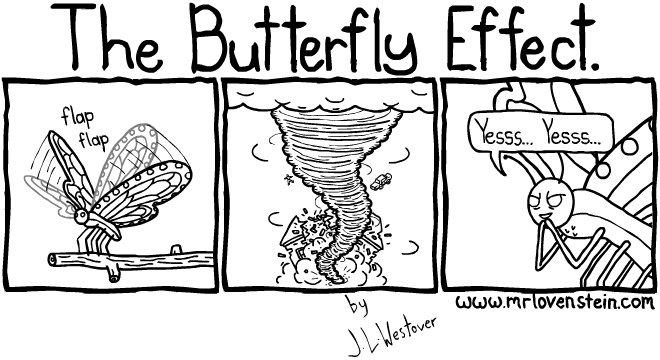History of the term "butterfly effect"
Edward Norton Lorenz discovered the butterfly effect or what is the basis of chaos theory in 1961 in the midst of his regular job as a research meteorologist. He was born on May 23, 1917 in the United States and have an educational background in mathematics and meteorology from MIT. In attempting to forecast the weather, he completed 12 non-linear differential equations with a computer.
At first he printed the results of calculations on a piece of paper with a format of six decimal places (..., 506 127). Then, to save time and paper, he included only three decimal places (..., 506) and subsequent mold is repeated on the same paper that already contains the results of earlier prints. An hour later, he was surprised by the results very different than expected. At first the two curves are squeezed, but gradually shifted to form a pattern that is another thing altogether. [1] In 1963, Lorenz published a theoretical study of this effect in a famous article entitled Deterministic Nonperiodic Flow ("non-periodic flow that determines") [2]. Based on the article, then he said: "A meteorologist found that if the theory is correct, then a sea gull wings (Seagull) can alter the course of weather forever." On the advice of his colleagues, in the lectures and subsequent publications, Lorenz used the more poetic example, the use of butterflies. According to Lorenz, a time he did not have a title for his talk at the 139th meeting of the American Association for the Advancement of Science in 1972, Philip Merilees suggested the title "Does the flap of a butterfly's wings in Brazil set off a tornado in Texas?" ("Does a butterfly flapping its wings in Brazil sparked tornado in Texas?"). Although the flutter of butterfly wings remain constant in this concept, the location of the butterfly, its impact and the location of these impacts can then be bervariaasi wide. [3] Flutter of butterfly wings in theory lead to very small changes in Earth's atmosphere that ultimately change the course of a hurricane (tornado), or delay, accelerate even prevent the occurrence of tornadoes in other places. This refers to the beating of wings of small changes of initial conditions of a system, resulting in a chain of events leading to large-scale changes (compare: "domino effect" or the domino effect). If a butterfly flaps its wings it is not, the system trajectory will be different. Note that the butterfly does not cause a hurricane or tornado. Flapping wings is part of the initial conditions: one set of conditions produce tornadoes, while others do not set conditions. It may be the set of conditions that do not involve a butterfly flapping its wings causes a hurricane. The term "butterfly effect" is not used in this story, but the origin of the use of butterflies in this concept is from a story written in 1952 by Ray Bradbury, "A Sound of Thunder" ("The sound of thunder").Dari berbagai sumber

please give your suggestions and comments on my blog.
ReplyDeleteif any input, I would like to thank to you ...?